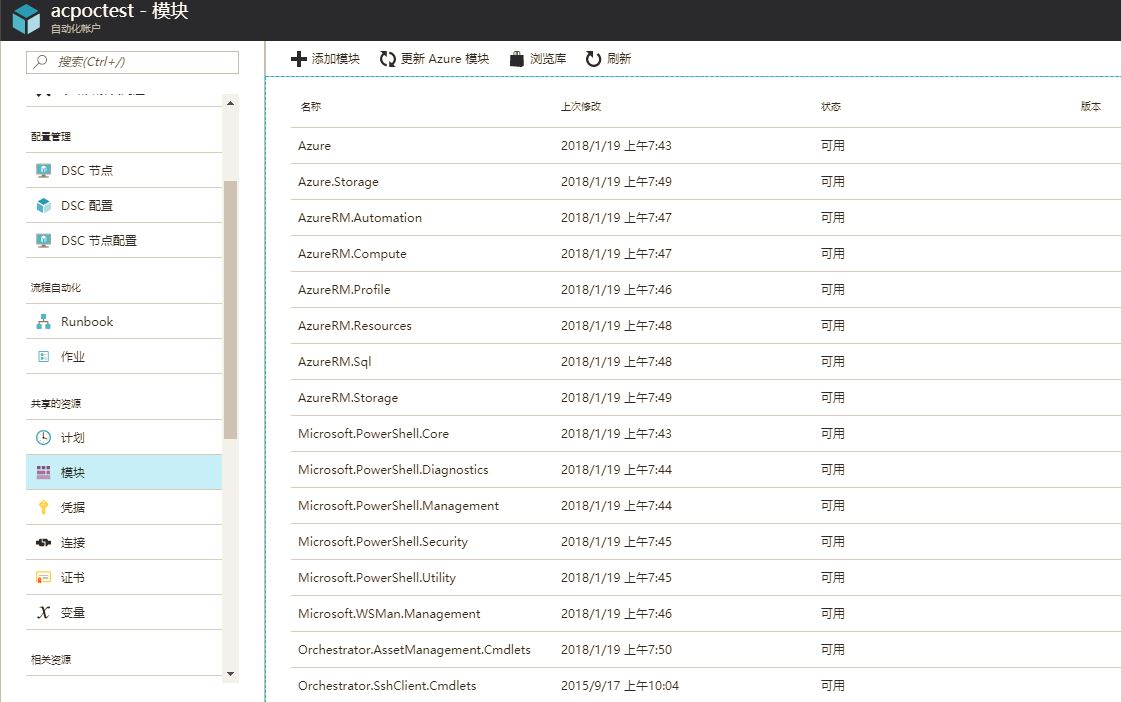新版Azure Automation Account 浅析(二) --- 更新Powershell模块和创建Runbook
前篇我们讲了怎样创建一个自动化账户以及创建时候“Run As Account”选项背后的奥秘。这一篇针对在Azure自动化账户中使用Powershell Runbook的用户讲一下怎样更新powershell 模块。
更新Powershell模块
首先,我们需要先了解一下Azure Automation的系统架构。我们已经知道用户可以通过运行Runbook来实现自动化运维,Runbook运行则是在Azure Automation的沙盒里执行的,沙盒是一组由Azure管理的虚机资源, 我们可以把其当做是Azure的一个PaaS服务。Pass服务自然是需要提供可伸缩高可用多租客隔离的运行环境。显然,我们需要能够为Runbook的运行环境指定所需要的Powershell模块和版本。同时,我们还需要能够升级更新相关的powershell模块。
打开我们前面创建的azpoctest自动化账户,在左边菜单选择“共享的资源”-》“模块”。
非常好,用户可以添加自定义的模块“添加模块”,也可以升级已有模块版本“更新Azure模块”。用户还可以浏览powershell模块库来导入新模块。

仔细研究一下这个页面,目测创建自动化账户时候自带的模块远少于目前Azure已经release的Powershell模块。如果需要运行Runbook来自动化运维Azure资源的话,目前这些模块是远远不够的。
记得光是ARM相关的powershell模块就有几十个,一个个导入的话工作量实在太大,那我们能不能像在powershell 命令行那样,用Install-Module和Import-Module两条命令就可以完成所有AzureRM
相关的模块安装呢?
点击“浏览库”,选择“AzureRM”,点击“导入”。“确定”按钮是灰色的,显然在Azure Portal中不支持有依赖关系的模块集中导入。

记得16年在Global做Automation Account的时候,毫无怨言地填坑,手动一个个把这些模块导入。今天我们换个填坑的法子
接下来我们会写一个Runbook,用脚本来导入AzureRM的Powershell模块
创建Runbook
在自动化账户左边菜单选取“流程自动化”-》“Runbook”-》“添加Runbook“ ,创建一个新的Runbook

创建成功后,浏览器会自动跳转到Runbook编辑器,我们可以开始写Powershell脚本了
首先,因为Runbook是运行在一个多租户的沙盒中,我们需要登录这个自动化账户所在的Azure订阅才能为这个自动化账户导入模块。
登录的代码可以reuse我们在上一篇提到的Runbook模板
$connectionName = "AzureRunAsConnection"
try
{
# Get the connection "AzureRunAsConnection "
$servicePrincipalConnection=Get-AutomationConnection -Name $connectionName "Logging in to Azure..."
Add-AzureRmAccount `
-ServicePrincipal `
-TenantId $servicePrincipalConnection.TenantId `
-ApplicationId $servicePrincipalConnection.ApplicationId `
-CertificateThumbprint $servicePrincipalConnection.CertificateThumbprint `
-EnvironmentName AzureChinaCloud
}
catch {
if (!$servicePrincipalConnection)
{
$ErrorMessage = "Connection $connectionName not found."
throw $ErrorMessage
} else{
Write-Error -Message $_.Exception
throw $_.Exception
}
}
接下来,我们需要在Powershell Gallery里查找导入模块及其版本,如果存在,我们会先去找一个模块实际存储的Blob Storage地址,用New-AzureRmAutomationModule这条命令来导入
如果有Dependency的模块,脚本会首先去导入Dependency模块。下文脚本包含了资源组,自动化账户,模块(AzureRM)和模块版本(最新),考虑到模块和模块版本在不同时期可能有变化,这2部分其实可以做参数化,由Automation的variable来存储。那样脚本就不需要经常修改。
param(
[Parameter(Mandatory=$true)]
[String] $ResourceGroupName, [Parameter(Mandatory=$true)]
[String] $AutomationAccountName, [Parameter(Mandatory=$true)]
[String] $ModuleName, [Parameter(Mandatory=$false)]
[String] $ModuleVersion
) $ModulesImported = @() function _doImport {
param(
[Parameter(Mandatory=$true)]
[String] $ResourceGroupName, [Parameter(Mandatory=$true)]
[String] $AutomationAccountName, [Parameter(Mandatory=$true)]
[String] $ModuleName, # if not specified latest version will be imported
[Parameter(Mandatory=$false)]
[String] $ModuleVersion
) $Url = "https://www.powershellgallery.com/api/v2/Search()?`$filter=IsLatestVersion&searchTerm=%27$ModuleName%27&targetFramework=%27%27&includePrerelease=false&`$skip=0&`$top=40"
$SearchResult = Invoke-RestMethod -Method Get -Uri $Url -UseBasicParsing if($SearchResult.Length -and $SearchResult.Length -gt ) {
$SearchResult = $SearchResult | Where-Object -FilterScript {
return $_.properties.title -eq $ModuleName
}
} if(!$SearchResult) {
Write-Error "Could not find module '$ModuleName' on PowerShell Gallery."
}
else {
$ModuleName = $SearchResult.properties.title # get correct casing for the module name
$PackageDetails = Invoke-RestMethod -Method Get -UseBasicParsing -Uri $SearchResult.id if(!$ModuleVersion) {
# get latest version
$ModuleVersion = $PackageDetails.entry.properties.version
} $ModuleContentUrl = "https://www.powershellgallery.com/api/v2/package/$ModuleName/$ModuleVersion" # Make sure module dependencies are imported
$Dependencies = $PackageDetails.entry.properties.dependencies if($Dependencies -and $Dependencies.Length -gt ) {
$Dependencies = $Dependencies.Split("|") # parse depencencies, which are in the format: module1name:module1version:|module2name:module2version:
$Dependencies | ForEach-Object { if($_ -and $_.Length -gt ) {
$Parts = $_.Split(":")
$DependencyName = $Parts[]
$DependencyVersion = $Parts[] # check if we already imported this dependency module during execution of this script
if(!$ModulesImported.Contains($DependencyName)) { $AutomationModule = Get-AzureRmAutomationModule `
-ResourceGroupName $ResourceGroupName `
-AutomationAccountName $AutomationAccountName `
-Name $DependencyName `
-ErrorAction SilentlyContinue # check if Automation account already contains this dependency module of the right version
if((!$AutomationModule) -or $AutomationModule.Version -ne $DependencyVersion) {
$DependencyVersion = $DependencyVersion.Split("[")[].Split("]")[]
Write-Output "Importing dependency module $DependencyName of version $DependencyVersion first." # this dependency module has not been imported, import it first
_doImport `
-ResourceGroupName $ResourceGroupName `
-AutomationAccountName $AutomationAccountName `
-ModuleName $DependencyName `
-ModuleVersion $DependencyVersion $ModulesImported += $DependencyName
}
}
}
}
} # Find the actual blob storage location of the module
do {
$ActualUrl = $ModuleContentUrl
$ModuleContentUrl = (Invoke-WebRequest -Uri $ModuleContentUrl -MaximumRedirection -UseBasicParsing -ErrorAction Ignore).Headers.Location
} while(!$ModuleContentUrl.Contains(".nupkg")) $ActualUrl = $ModuleContentUrl Write-Output "Importing $ModuleName module of version $ModuleVersion from $ActualUrl to Automation" $AutomationModule = New-AzureRmAutomationModule `
-ResourceGroupName $ResourceGroupName `
-AutomationAccountName $AutomationAccountName `
-Name $ModuleName `
-ContentLink $ActualUrl while(
$AutomationModule.ProvisioningState -ne "Created" -and
$AutomationModule.ProvisioningState -ne "Succeeded" -and
$AutomationModule.ProvisioningState -ne "Failed"
)
{
Write-Verbose -Message "Polling for module import completion"
Start-Sleep -Seconds
$AutomationModule = $AutomationModule | Get-AzureRmAutomationModule
} if($AutomationModule.ProvisioningState -eq "Failed") {
Write-Error "Importing $ModuleName module to Automation failed."
}
else {
Write-Output "Importing $ModuleName module to Automation succeeded."
}
}
} _doImport `
-ResourceGroupName "chdaiAC" `
-AutomationAccountName "acpoctest" `
-ModuleName "AzureRM" `
-ModuleVersion $ModuleVersion
编辑完成,点击保存。随后继续点击“测试窗格”。这个功能将测试我们刚完成的Runbook。
在输出窗口会看到后台沙盒运行脚本把AzureRM的dependency模块一个个被导入到自动化账户

最后导入AzureRM的时候运行会报错,这个没有关系。AzureRM模块本身不包含任何功能。所以ARM管理的Powershell命令都在AzureRM的Dependency 模块里。
现在回到模块列表,可以看到AzureRM相关模块已经全部导入了

现在万事具备,下一篇我们可以开始在日常工作中运用Azure自动化账户
新版Azure Automation Account 浅析(二) --- 更新Powershell模块和创建Runbook的更多相关文章
- 新版Azure Automation Account 浅析(三) --- 用Runbook管理AAD Application Key
新版Azure Automation Account 浅析(三) --- 用Runbook管理AAD应用的Key 前篇讲过有一个面向公众的Runbook库,社区和微软一直往其中加入新的Runbook, ...
- 新版Azure Automation Account 浅析(一) --- 创建和Run As Account
去年年底Azure中国的Automation Account悄悄做了升级.新版本不管从功能还是end user experience方面都让人耳目一新.如果说升级前只是一个运行脚本的小工具,升级后的A ...
- 利用Azure Automation实现云端自动化运维(1)
Azure Automation是Azure上的一个自动化工作流引擎,基于Powershell,来帮助用户简化,集成和自动化Azure上的运维工作,例如: 实现定时开关虚拟机,节约成本 实现定时创建删 ...
- Step by Step 用Azure Automation 来开虚机(ARM)
使用Azure Automation来自动化处理各种重复的耗时的云管理任务从而帮助云运维人员提升效率,帮助降低运营成本. 具体相关的介绍以及怎样利用Azure Automation来完成定期开关虚拟机 ...
- 【Azure Developer】Azure Automation 自动化账号生成的时候怎么生成连接 与证书 (Connection & Certificate)
Azure Automation :The Azure Automation service provides a highly reliable and scalable workflow exec ...
- Azure Automation (1) 入门
<Windows Azure Platform 系列文章目录> 通过Azure Automation(自动化),开发人员可以自动完成通常要在云环境中执行的手动.长时间进行.易出错且重复性高 ...
- Azure Automation (2) 定期删除存储账号中的文件
<Windows Azure Platform 系列文章目录> 本文介绍的是国内由世纪互联运维的Azure China. 本文是对笔者之前的文档Azure Backup (1) 将SQL ...
- Azure Automation:存储帐户之间blob拷贝
在两个存储帐户之间进行blob拷贝,在客户端,使用Azue PowerShell脚本, 用存储帐户上下文(New-AzureStorageContext)来获取某个StorageAccount中的Co ...
- 如何利用Azure Automation以及Tag自动开关VM
这是本博客第一篇技术相关的小贴士,在这里我不会详细介绍所涉及的技术组件的具体使用细节,因为我相信这些大家都可以通过官方文档了解到.如果你是一个看了官方文档依然一脸茫然的IT小白,个人建议是先从基础重新 ...
随机推荐
- 删除SVN版本信息的两种方式
一.在linux下删除SVN版本信息 删除这些目录是很简单的,命令如下 find . -type d -name ".svn"|xargs rm -rf 或者 find . -ty ...
- Django_调查问卷
1.问卷的保存按钮 前端通过ajax把数据发过来后端处理数据,然后返回给前端2.对问卷做答 首先用户进行登录,验证 条件:1.只有本班的学生才能对问卷做答 2.已经参加过的不能再次访问 ...
- Debian安装fail2ban来防止扫描
vps的root密码不要设置的太简单,这样很容易被攻破,你可以安装如下软件来降低vps被攻破的机会. 输入如下命令: apt-get install fail2ban 提示如下表示安装完成: root ...
- jQuery 属性操作方法(五)
方法 描述 addClass() 向匹配的元素添加指定的类名. attr() 设置或返回匹配元素的属性和值. hasClass() 检查匹配的元素是否拥有指定的类. html() 设置或返回匹配的元素 ...
- 一个简单JDK动态代理的实例
动态代理的步骤: 创建一个实现了InvocationHandler接口的类,必须重写接口里的invoke()方法. 创建被代理的类和接口 通过Proxy的静态方法 newProxyInsatance( ...
- 配置不同环境下启用swagger,在生产环境关闭swagger
前言 Swagger使用起来简单方便,几乎所有的API接口文档都采用swagger了.使用示例:http://www.cnblogs.com/woshimrf/p/swagger.html, 现在开发 ...
- PHP正在进行时-变量
在PHP中,变量是$+变量名,变量名遵循标识符的命名规则,可以以字母.下划线开头,可以由数字.下划线.字母组成合法的变量名. 变量声明 所有变量在使用之前应该进行声明,而且最好带上注释,虽然在PHP中 ...
- C语言中不同变量的访问方式
C语言中的变量大致可以分为全局变量,局部变量,堆变量和静态局部变量,这些不同的变量存储在不同的位置,有不同的生命周期.一般程序将内存分为数据段.代码段.栈段.堆段,这几类变量存储在不同的段中,造成了它 ...
- dulicate symbol for architecture i386 或者其他什么CPU架构 比如i386
昨天群里有个哥们遇到和么一个问题 , 错误的大概意思呢,就是 重复定义了 一个名字. 解决办法,只能修改名字啊. 而且,错误信息 也很明确的 支出了 重复定义的类文件名字PassGuardViewC ...
- Git的使用-如何将本地项目上传到Github
默认你的电脑上已经安装了git. 第一步:我们需要先创建一个本地的版本库(其实也就是一个文件夹). 你可以直接右击新建文件夹,也可以右击打开Git bash命令行窗口通过命令来创建. 现在我通过命令行 ...
